Air crashes at Hanworth Aerodrome
Air disasters hold a continuing fascination in the public mind. Perhaps we have a deep-seated fear of being airborne? From aviation’s earliest days, incidents involving aircraft have been widely reported. Accidents at Hanworth have appeared in newspapers as far afield as Dundee and Belfast and were often covered by the national press. As with airfields today, local residents appeared to hold mixed views about the Air Park. There were some complaints about the noise and particularly, the low flying aircraft. However, with the approach of the Second World War, people increasingly appreciated that the skills of these airmen would be needed.
Feltham Arts Association produced a book of reminiscences which included a chapter by Peter Hocking on crashes at the Air Park. I am not attempting to reproduce his excellent work, which drew on the recollections of many Feltham and Hanworth residents. What follows is also not an exhaustive list of all the incidents which happened while the aerodrome was operating – from 1919 to 1949. Rather, I have tried to draw out some of the stories of those involved in the accidents – even a minor injury could have life-changing impacts. There are some colourful characters but one of the most noticeable things is the youthful age of the flyers; and this was painfully obvious during the war years. But the matter of fact reporting of the time suggests that death and tragedy was more part of life, during peace or war-time.
Note: The National Flying Service, a commercial flying school, had its headquarters at Hanworth from 1929. Airplanes and instruction could be rented from them. They are referred to as NFS in this blog.
The sad fate of the experimental parachutist (25th July 1918)
Captain Payne, Flight Commander in the RAF and Edwin Boyle, 22 a young engineer with Whitehead Aircraft, flew in a Martinsyde Scout to experiment on a new parachute which they had invented. Boyle was dressed in a full parachute harness and was sitting in the observer’s seat in front of the pilot. At a height of 120 metres Boyle stepped out of the plane and onto a specially-fitted platform on the wing. The parachute case (attached from Boyle to the side of the carriage by a cast iron hook) should have been left behind. However, the hook broke and Boyle fell to earth with the parachute still in its case. At the inquest, it was suggested that the hook was brittle, but evidence from the Whitehead foreman, William Hanley, said it had been tested by a ton dead load weight (1,000 kg). Whitehead Aircraft did not manufacture the hook, and the manager there thought that steel would have been more reliable than cast iron. Captain Payne agreed that a high tensile metal, such as steel, would have been much more suitable.
This was Boyle’s first ever descent using a parachute and sadly, it was to be his last. Onlookers saw him hit the ground, breaking his neck and fracturing his skull, dying instantaneously. He had worked at Whiteheads for two years, and was highly regarded by the firm, who paid tribute to the young inventor in their in-house magazine.
The first airplane death at Hanworth (Simmonds ‘Spartan’ G-AAMC – 28th July 1929)
The Simmonds-Spartan, a light 2-seater bi-plane, was one of the airplanes used by National Flying Services (NFS), headquartered at Hanworth, for their training. On 28th July 1929 the aircraft was being spun during low acrobatics when it crashed into trees and caught fire on impact. Both the occupants were thrown out. The pilot, Flying Officer Jack Harley Caulfield (aged 25) who died of his injuries two days later in Hounslow Hospital, was described as a skilful young airman recently engaged by the NFS. His passenger, Percy Read, of Twickenham, survived but suffered shock and facial injuries and was treated at St John’s Hospital, Twickenham.
Jack Caulfield had been married only a month before and was living nearby at the Yews, in Sunbury. He had joined NFS on 15th June that year, as one of the stunt pilots in the air circus they were forming.
The fatal flight only lasted only 12 minutes when it spun from a height of 30 metres into trees. Giving witness for NFS, Captain Thomas Neville Stack, their chief pilot, said “A thing you must remember on the question of low stunting is that it appeals very much indeed to the younger generation.” He continued: “And when they suffer a little sometimes from over-confidence they stunt low even against orders. A man may be an experienced pilot, but in the fact he flies low he may take unnecessary risks.”
Another witness believed that Mr Caulfield had done over 13 hours flying in the same machine, and had seen him roll it on a previous occasion, but at a safe height of 450 – 600 metres. However, Caulfield had previously been warned by other NFS pilots to stop flying low. Neighbours too had complained about the low flying although some of the witnesses for the NFS claimed that these aircraft could have come from nearby Heston or Service (RAF) machines passing over the district. All agreed that Caulfield had successfully executed his roll manoeuvre but badly recovered from it and most likely stalled on the way out and went into a spin. Caulfield’s sister, who was with him before he died, believed that he said “I must keep clear of the water” or “the river.”
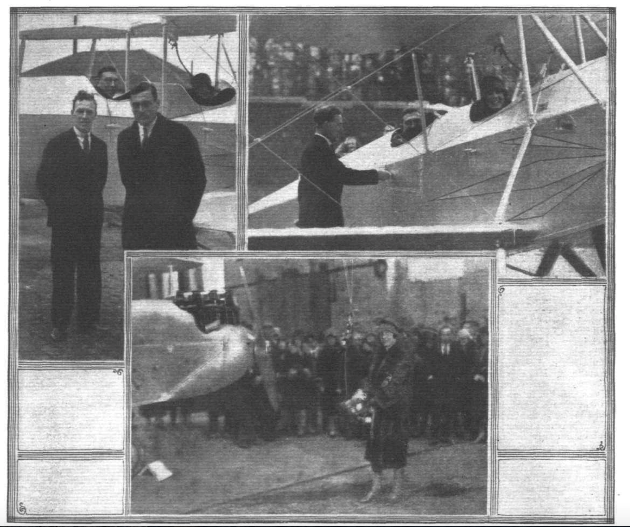
The first Simmonds ‘Spartan’ being christened (Flight, 3 Jan 1929)
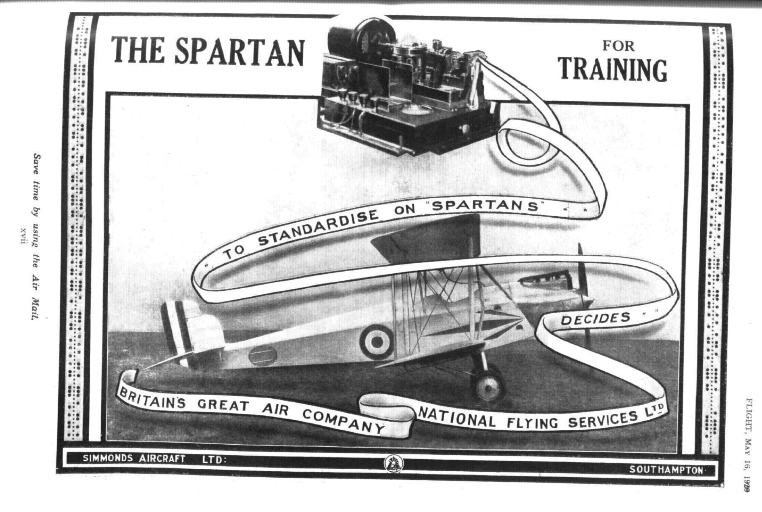
Spartan advertisement (Flight, 16 May 1929)
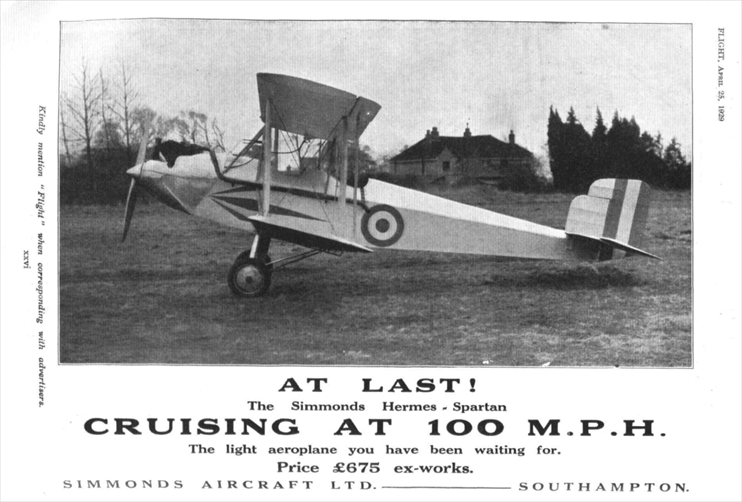
Advertisement for the Spartan (Flight, 25 Aug 1929)
The Bluebird which crashed into Powell’s Orchard in Feltham (Blackbird ‘Bluebird’ G-AAOA – 6th April 1930)
The life of this particular Bluebird was fairly short as it was written off when it was under six months old. According to witnesses, the airplane was flying very low, as if the pilot was going to land, when it spun out of control on its initial climb and nose-dived into Powell’s Orchard at Feltham. The machine caught fire immediately on impact with the trees. The pilot, 28 year-old George Edward Watts of Totnes, was dragged away from the blazing machine by people who rushed to the scene. He was heard to shout ‘Pull me out, pull me out’ but the extent of his burns was such that he was pronounced dead on arrival at Hanworth Cottage Hospital. Watts was described at the inquest as a very promising young pupil who had only been flying a few months with the NFS at Hanworth.
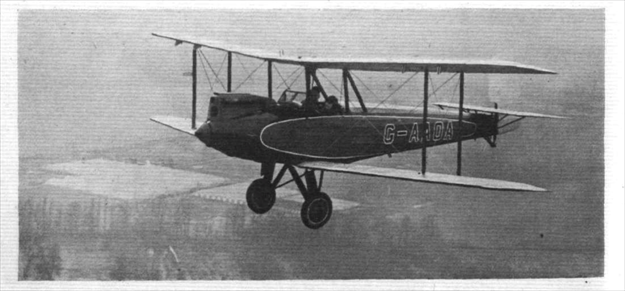
The Bluebird which crashed at Hanworth (Flight, 4 April 1930)
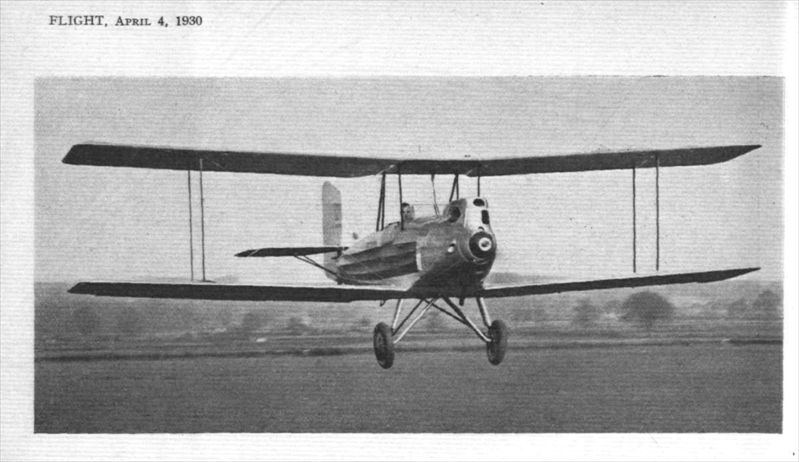
The Bluebird (Flight, 4 April 1930).
The one which crashed into a garden in Acacia Road, Hampton (De Havilland ‘Moth’ G-AAPN – 6th May 1930)
This aircraft, also owned by NFS, was written off when it crashed into the garden of a house on Acacia Road, Hampton near to Fulwell Golf Course on the 6th May 1930. The only occupant, the pilot Hugh Elliott, aged 49, was killed.
Elliot, the grandson of the 3rd Earl of Minto, was a well-known man in public life who had gained some fame as a soldier, philosopher and scholar: he was also considered one of the greatest bridge experts in the country. One accomplishment he did not have was that of airman.
At the time of the crash he was taking an altitude test, the final test to enable him to obtain a pilot’s licence, and had ascended to a height of 3,000 metres. His instructor told him under no circumstances to go into a cloud or lose sight of the aerodrome. The next thing the instructor saw was the machine coming down in an upside-down position from a height of about 1,000 metres. The airplane continued its inverted dive, which the instructor said was a ‘very highly specialised job’ and not at all the same as looping the loop, where there is no feeling of being upside down. The coroner decided that there was no evidence of negligence on the part of the instructor or the flying school and that it was ‘one of those unfortunate accidents which will occur’.
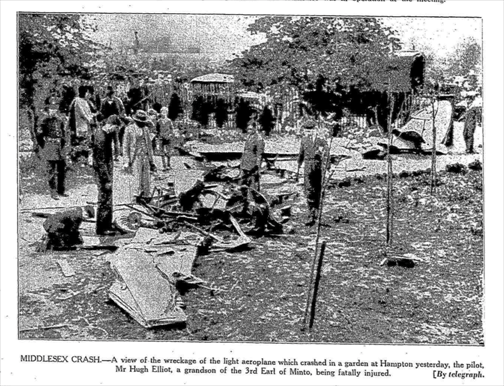
Photo: ©The Scotsman, 7 May 1930
The monoplane designed by its pilot (Angus ‘Aquila’ G-ABIK – 21st March 1931)
The Angus Aquila was a one-off, single-seat low-wing monoplane, designed and built by its owner and pilot. Arthur Leighton Angus, aged 25, from Chippenham was not a member at Hanworth but rented a hangar there. According to eye witness accounts, on 21st March 1931, the pilot had waved goodbye to a group of people in the aerodrome, took off very well and climbed to a height of 30-45 metres and then entered a steep left turn. This turned into an almost vertical roll at the end of which the Aquila fell with a sheer dive to the ground and Angus was killed on impact.
The one flown by Maitland Warne (De Havilland ‘Moth’ G-AAPO – 20th February 1932)
If the court reports of one George Lawrence Maitland Warne refer to the same man, then Warne’s luck finally ran out on 20th February 1932 at Hanworth. When a young man, Warne had been summoned by the Petty Sessions court in Buckinghamshire to answer a charge of assault brought by Thomas Crawford. The offence was alleged to have occurred at Bletchley on November 25th 1911. Warne would have been 25 at the time and although he was not convicted, he did have to pay costs, suggesting that the court thought there was some guilt on his part.
A man of the same name was fined in October 1925 for failing to give audible warning of his approach in a motor vehicle in Balham. A furniture lorry was driving between 12 and 15 miles an hour and before reaching the cross roads at a junction had sounded its hooter several times, but received no response. In those days, drivers had to warn other vehicles of their approach at junctions. Warne, aged 39 at the time and from nearby Streatham, was driving at 25 to 30 miles an hour, claimed that he didn’t sound his horn as he thought he had a clear road ahead.
In February 1932, Maitland Warne was flying an NFS registered De Havilland Moth. During the initial climb, it went out of control and spun into the ground. Warne died ten months later of his injuries.
The Heracles which fell into the Longford river (Handley Page ‘Heracles’ G-AAXC – 19th June 1932)
It was the day of the Royal Aeronautical Society’s annual garden party with over 600 visitors. People were literally ‘dropping in for a cup of tea’ from the air from aircraft of all sizes. However Imperial Airways Heracles which had been flown over from Croydon, took the biscuit.
Heracles was a nine-ton liner which was usually on the cross-channel service from London to Paris. As it was taxiing across the aerodrome at Hanworth preparing to take off with a load of joy-riders on the last trip of the day, the pilot crashed into the Longford river. The river had been banked over and fortified in other to withstand ordinary light aircraft, but not something as big as the Heracles. Her left wheel and undercarriage dropped several metres and became embedded in the river below. Luckily none of the 32 passengers on board were hurt: ‘We felt a terrific bump and thought at first that one of the wheels had come off’ one of the passengers said. He then expressed disappointment at having been done out of their flight.
The fast and famous Gypsy Moth (De Havilland ‘Moth’ G-AAHR – 1st October 1933)
Although George Archdale was the registered owner and was at the controls when it stalled on a loop and spun crashing to the ground in Sunbury, this Gypsy Moth had an illustrious backstory. It was built as a two-seat cabin racer in 1929 by De Havilland at their Edgware works with a special racing undercarriage for the specific use of a Captain Hubert ‘Pull-Over’ Broad, winner in 1929 of the La Coupe Zenith, the International Speed Contest around France. Captain Broad continued to race her in 1930, selling her later that year. Theodore C. Sanders bought the aircraft from Phillips and Powis Aircraft and flew it with Mr M. Simaika from Heston to Cairo in March/April 1931. George Archdale registered it under his name at Hanworth in November 1932.
The lucky passengers (Desoutter G-AATF – 9th May 1934)
While it was trying to take off, this Desoutter aircraft failed to gain sufficient height and stalled. Its wheels clipped the top of a fence, ran across some private gardens and nose-dived with the tail of the plane striking the back of a house, narrowly missing the windows. The machine, which was a total wreck, was piloted by Mr Kerwin who lived at Hanworth Flying Club and was taking two passengers, Mr W. Courtenay, and Mr F. Hoofa. All three occupants were lucky to escape with minor injuries.
The young couple (De Havilland ‘Moth’ G-OCOA – 20th August 1936)
This may have been Captain Glen’s attempt to impress 19 year-old Irene Park. If so, the date did not go as well as he might have hoped. After taking off from Hanworth, the undercarriage struck a sewerage stackpipe in Elmwood Avenue, Feltham with the aircraft landing upside down in the middle of the road. Miss Park was trapped under the machine which had to be lifted before she could be freed. She was said to be suffering from minor cuts and shock. Captain Glen suffered minor injuries.
The promising engineer (Broughton-Blayney ‘Brawney’ G-AENM – 21st March 1937)
The pilot, Alexander Bailey Scaife, aged just 22, was killed when the aircraft spun into the ground while executing a steep turn. According to the Western Morning News, the machine skimmed the top of a stationary car and narrowly missed a number of pedestrians before crashing into the back of the guardroom of the R.A.S.C. (Royal Army Service Corps) depot.
One witness recalled that the pilot was killed by the joystick going through his body, although this was not mentioned at the inquest where the court was told Scaife died in hospital from a fractured skull and multiple injuries. It was reported that the aircraft stalled and narrowly missing a house when it crashed onto a road.
Scaife was originally from Keighley in Yorkshire and had been following in his father’s engineering footsteps. He had learnt to glide at home while developing his interest in aeronautics. Moving to Hanworth, he became an experimental pilot who had been working on the design of a new pattern of monoplane. The Brawney was the first of its type to be built with a long wing and short body. Scaife had been thinking about buying it and had flown his mother in a different larger plane earlier that day.
The one which crashed into the house on Hounslow Road (Percival ‘Vega Gull’ G-AERH – 29th May 1937)
Saturday 29th May 1937 was Britain’s fourth Empire Air Day and one of the blackest days in the early history of British aviation. Seventeen people were killed over that weekend, including these three in Hanworth at the start of the Isle of Man air race.
The pilot, Sydney William Sparkes, aged 41, was an experienced airman and manager of the Queen’s Arms Hotel, Wallasey, Merseyside. His passenger was Charles Fry, 46, a pawnbroker, also from Wallasey. Both pilot and passenger died along with Mrs Elsie Abbey, 40 who lived in the house which the airplane crashed into, with her husband and 12 year-old son. The coroner, Reginald Kemp, described the accident as ‘a terrible tragedy – one of the saddest in my long experience’.
The Vega Gull monoplane was the 14th plane to take off for the Isle of Man race which started from Hanworth that year. The airplane took off around 12.30pm but as it was turning towards the Hounslow Road boundary of the aerodrome, onlookers were horrified to see one of the wings clip a tree and crash into the roof of number 215 Hounslow Road. Some of the huge crowd attending the race rushed to the scene of the crash and police had to keep them away. Neighbours assisted the police and fire brigade to try to extricate the casualties, several of the police officers receiving burns to their hands.
Mrs Abbey had been in bed in her front room recovering from an operation the day before when the crash happened. PC McRobbie who was in Hounslow Road when the crash happened used his truncheon to break the window pane and rescue Elsie, whose clothing was in flames. Her husband and their 12 year-old son Stanley were also treated for burns. The house was described to the inquest jury as ‘burning like a furnace’ and within an hour was a burnt-out shell.
At the time, Sydney Sparkes was the private pilot to Mr William Porter of the Nelson Preserving Company, Liverpool, who owned the machine. The inquest heard that Sparkes was an experienced and well-known airman at the RAF airfield at Hooten Park, Cheshire, where he had served with the RAF from 1919 – 1931. Prior to obtaining his pilot’s licence in 1922, he had served with the R.N.A.S. (Royal Naval Air Service). He was a flying instructor at Sealand Aerodrome, near Chester for several years, and, in 1928, became the first voluntary flying instructor of the newly-formed Liverpool and District Flying Club. He had taken part in the King’s Cup Race in 1934, 1935 and 1936, racing Mr Porter’s airplanes. He was regularly seen giving exhibitions at an air circus which he organised. He was also a keen motorcyclist and, in 1928, had created a record for travelling round the world on a motorcycle and side-car in 157 days. His passenger in the Vega Gull was Charles Fry who had held a commission in the Royal Flying Corps during the war, but had not flown for 20 years.
Despite his experience, it seems that Sparkes had not made enough height on take-off, and tried to execute a steep turn. The lack of height led to the plane clipping a wing on the tree in front of number 215 and crashing into the roof. Parts of the airplane were found in the back garden, where the charred bodies of Sparkes and Fry were amongst the wreckage. The engine embedded itself into the masonry of number 217 next door, where Mr and Mrs Hilton lived. There did not appear to be anything wrong with the machine itself, and the jury found that an error of judgement on the part of the pilot led to the tragedy.
On the day itself, the traditional stiff upper lip had been on display. Organisers decided that the race should proceed, and six planes took off after the disaster, circling the plumes of smoke coming from the burning house as they left the aerodrome. Miss Florence Desmond, an actress who had performed the opening ceremony, had been ‘very upset’ by the tragedy which she witnessed. She nevertheless decided to continue with her intention of flying from Hanworth back to Hatfield that same afternoon. And the same newspaper articles which reported the tragedy at the time, gave considerable coverage in the same article to the rest of the race which continued as planned.
The entire Feltham and Hanworth community appeared shaken by the tragedy, which was reported in newspapers around the country and flying was suspended during the time of the funeral, which was apparently appreciated by the relatives. However, a petition was got up afterwards (it is not clear who started this) calling for the closure of the airfield.
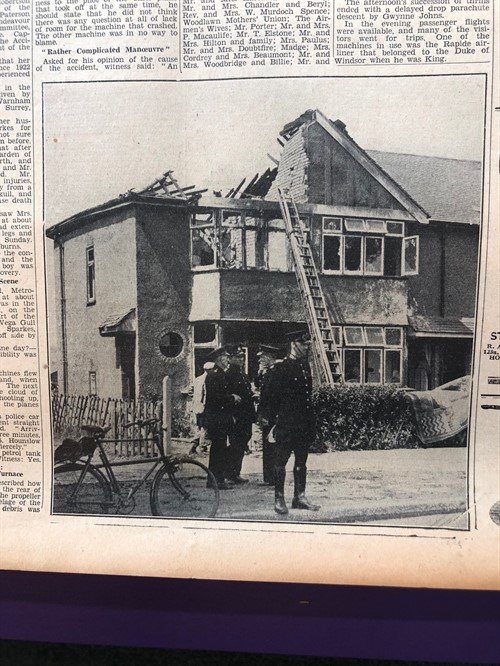
The wreckage of 215 Hounslow Road (The Middlesex Chronicle 5th June 1937)
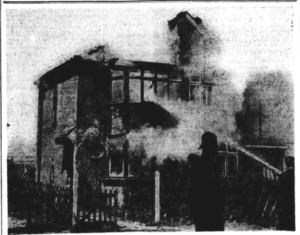
The Northern Whig and Belfast Post 31st May 1937 (www.britishnewspaperarchive.co.uk)
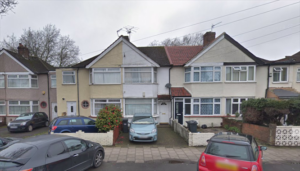
215 (left) and 217 Hounslow Road today (googlemaps)
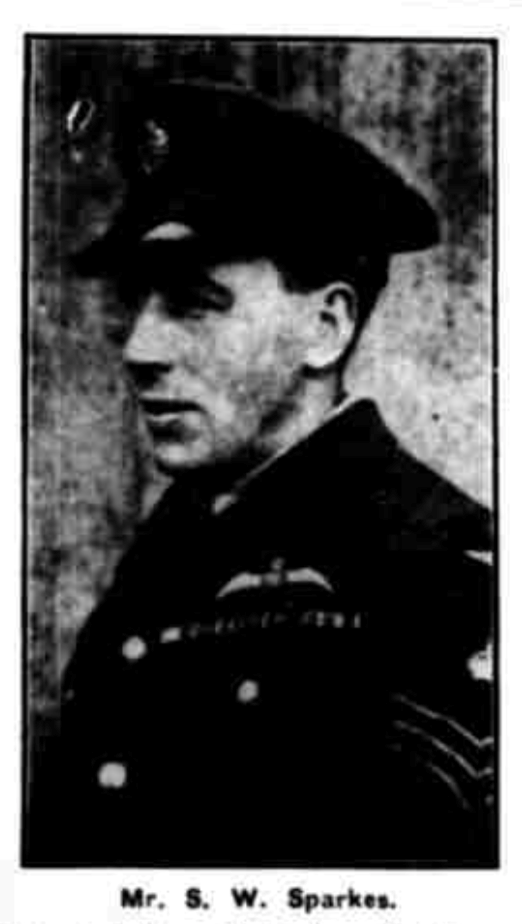
Mr S. W. Sparkes Liverpool Echo, 29th May 1937 (www.britishnewspaperarchive.co.uk)
The one which crashed into Queen Mary Reservoir (BA ‘Swallow’ G-AEWH – 23rd Aug 1937)
Herbert Willis, 29, was killed when he ditched his machine into Queen Mary Reservoir, near Shepperton. The airplane was a two-seater BA Swallow which was owned by the Midland Bank Flying Club. Willis, who lived in Carshalton, could well have been an employee of the bank. The plane nose-dived into the reservoir and exploded, with fragments of the wing and rudder scattered over the water. Neighbours who jumped into the water to help, could find no trace of the pilot amidst the floating wreckage, and it was assumed that he had drowned. It was eventually decided to drain the reservoir, which was believed to be the biggest in the world at the time, but there are no records of whether this happened or what was found.
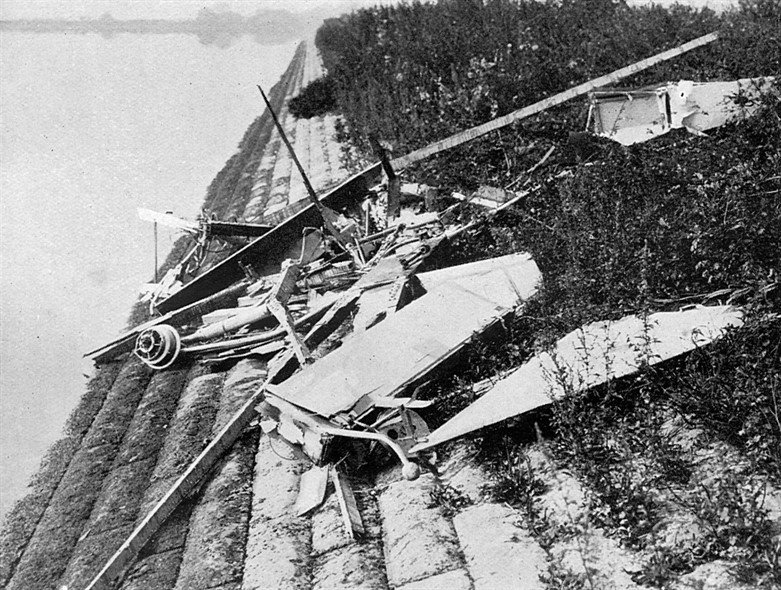
The Sphere 4th September 1937 © Illustrated London News Ltd / Mary Evans
The two planes which crashed into each other (Blackburn B2 G-AEBI and Hawker Hart K4434 – 1st Feb 1938)
Two planes both belonging to the RAF Elementary Reserve Flying Training School caught fire when a landing Hawker Hart collided with a Blackburn B2 on the ground. The young pilot of the Blackburn was trapped in his burning machine and died. Kenneth Wild was aged just 17 and had only joined the RAF 14 days earlier. He was on his first flight. Flying Officer Lawrence Chiswell, the pilot of the Hawker, received burns and was detained in hospital.
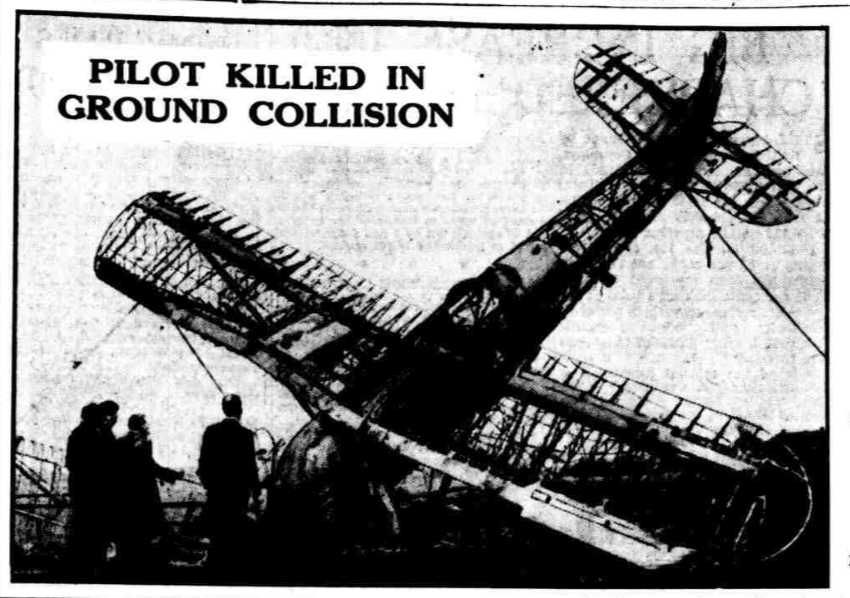
The Daily Herald 1st February 1938 (www.britishnewspaperarchive.co.uk)
The keen amateur (Avion ‘Bassour’ G-AFCD – 12th June 1938)
Walter Lewis, aged 44, lived in Richmond, Surrey and was a member of Hanworth Flying Club. Most summer Sunday evenings over the previous three months, Walter Lewis had driven to Hanworth to fly his airplane for about half an hour at a time. His wife, who apparently did not like flying, waited in the car each time, watching her husband in the air. On Sunday evening of the 12th June 1938, he bid goodbye to his wife, who was watching from the car on the tarmac. After what was described as a perfect take-off, witnesses said they heard an explosion as the aircraft reached 6 to 9 metres and the machine stalled and dived into the ground.
The commercial pilot (Avro G-ADEI – 16th May 1939)
This Avro was owned by the Air Advertising Company of Grimsby and was towing an advertising banner when it nose-dived into an orchard on the Uxbridge Road, shortly after taking off from Hanworth. The pilot, Sydney Lane Foster St Barbe, aged 44, was able to walk away from the crash, but died three days later from injuries he had sustained. His passenger, Richard Holmes, who was a director of the advertising company, survived and was able to describe the moments before the crash to the inquest.
St Barbe was a well-known and experienced commercial pilot, having obtained his licence in 1917 and served in the RAF during the war. He was one of the first pilots to fly the London to Paris route in 1919 and 1920. Despite this experience, his passenger said that they seemed to pull off the ground too early. As they flew over the houses, the machine suddenly dropped and the pilot had shouted ‘I can’t get it to climb’. There was not time to dive and the aircraft stalled and crashed into the orchard. Witnesses said that the aircraft seemed to be out of control and reported seeing one occupant, presumably the terrified passenger, standing up.
The crash during the Hanworth Air Day (Hawker Hurricane L1872 – 20 May 1939)
There were more thrills than expected for the thousands of spectators who flocked to the Hanworth Air Day display, part of the 78 air displays put on by the RAF in May 1939. A Hawker Hurricane service plane, which Flying Officer W.L. Robinson had earlier been demonstrating at high speed and low flying, crashed after landing. Earlier the Hurricane had been part of a ‘guess the height’ competition as it flew low over Hanworth park. Landing at the high speed necessary for this type of aircraft led it to career across the enclosure reserved for the public to view machines at close quarters, and into the steel railings on the edge of the field. It ended upside down in the neighbouring field where a cricket match was in progress. The pilot got out and walked away unhurt.
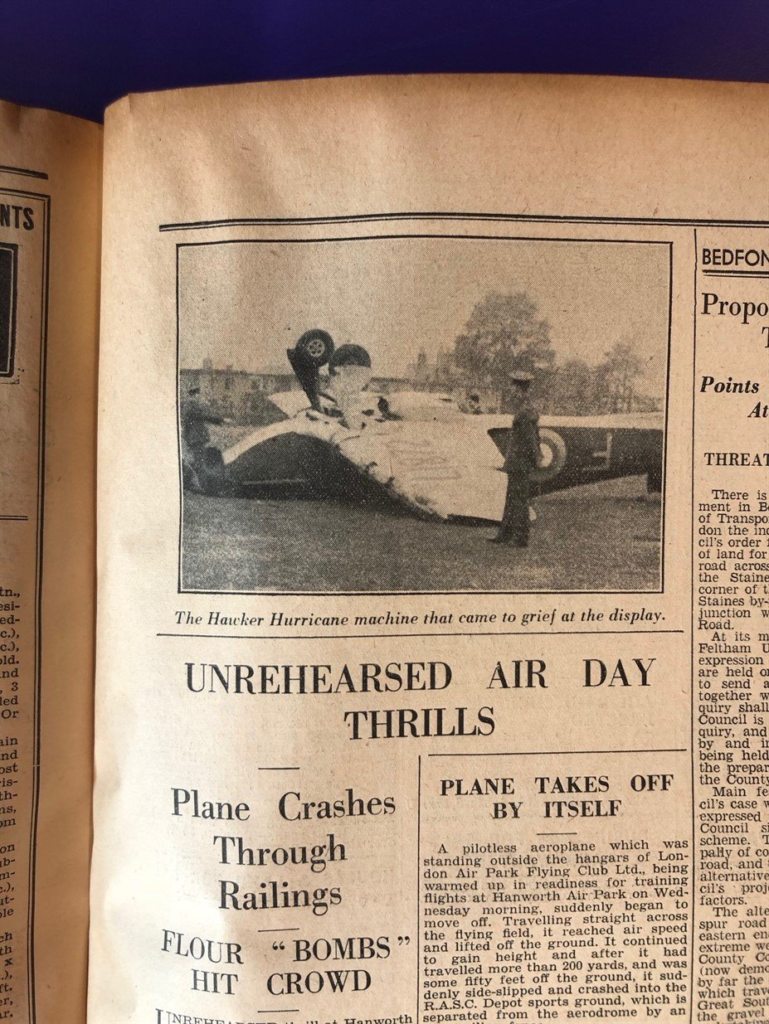
The Hawker Hurricane which crashed during the air display. (Middlesex Chronicle, 27th May 1939)
The pilotless escapee (B.A. Swallow G-AELV – 24th May 1939)
A pilotless airplane which was being warmed up in preparation for training flights, suddenly moved off of its own accord. Travelling straight across the flying field it reached air speed and lifted off the ground. Continuing to gain height, it was some 15 metres off the ground and had gone more than 200 metres when the airplane suddenly side-slipped, stalled and crashed into the R.A.S.C. (Royal Army Service Corps) depot sports ground, which was separated from the aerodrome by an iron railing fence.
There were reports that the pilot had swung the aircraft’s propeller, the engine had burst into life and having not chocked off the aircraft’s wheels, it began to taxi along the runway with the pilot chasing after it. Sadly there do not appear to be any photos of this event.
The one which crashed into Hanworth Road (BA Swallow. G-AFHN – 15th July 1939)
The crash occurred around 8 o’clock on a Saturday morning in July 1939 only a few minutes after pilot instructor Harold Ferguson, aged 32, had taken off with a Civil Air Guard pupil, Gordon Watson, aged 26. They were flying in a dual-controlled BA Swallow owned by the London Air Park Flying Club. Ten minutes after take-off while the airplane was still circling the aerodrome it went into a steep bank turn. Unable to recover from this, it dived into the yard of the Feltham Telephone Exchange from a height of 60 metres striking the roof of an outbuilding before crumpling in the yard. No one in the yard was hurt, although mail vans were being loaded at the time and there were houses within 6 metres on each side of the yard. The machine hit the ground with a terrific impact and was crumpled into a wreck. The petrol tanks burst, but luckily did not catch alight. Watson was extricated from the wreckage but the rescuers did not know that there was another person on board until they heard Ferguson’s groans. Ferguson died before the doctor arrived, but Watson was taken to Hounslow Hospital, badly shaken and suffering from a scalp wound.
Ferguson had three years’ flying experience and had been working at Hanworth for three months, exclusively flying Swallows. After the jury had recorded a verdict of accidental death and the coroner had said that no one was to blame, the coroner then commented that the accident could have happened from an error of judgement on the pilot’s part. This brought loud objections from the brother and friend of the pilot, who challenged this remark as being at odds with the coroner’s previous statement and the jury’s verdict. They added that there was no proof of who was at the controls at the time of the incident although the coroner took further evidence from Watson that it had been the pilot, Ferguson.
The one which crashed into Bedfont ATC Cadets (Spitfire V BM574 – 29th November 1942)
On Sunday November 29th 1942, the Bedfont Squadron of Feltham’s Air Training Corps (ATC) Cadets were on duty at the aerodrome when an RAF Spitfire overshot the boundary and ran into the two lines of boys. One, Cadet Allum of Waterloo Crescent, Feltham, aged 17 at the time, was killed and six others were injured in the accident.
Witnesses at the inquest described seeing the airplane coming in to land very fast, touching down about 160 metres from the outer edge of the aerodrome. It then appeared to skid, one wing crashing into an ambulance and narrowly missed a row of petrol pumps. The Flight Sergeant in charge of the cadets said that he thought that the airplane was landing a little too close to the road, but did not realise it was not going to stop, otherwise he would have warned the cadets to get out of the way.
The pilot of the Spitfire, Sergeant Anthony Smith, had been delivering the craft for inspection. Although he had never landed at Hanworth before (which was surprising given he lived in Isleworth), had made three observational circles as a precaution before landing. He had been told that Hanworth was a ‘very small ground for a machine of the type he was flying’ as the aircraft had a high landing speed. The pilot had been flying for 15 months and did not consider he was flying too fast. He realised he was overshooting the aerodrome as he touched down, but by then, it was too late to take off again due to the number of buildings nearby. Although the pilot applied the brakes, it was impossible to do so at once when landing at speed. The coroner found that the pilot had not been negligent and that the cadet’s death and the injuries suffered by the other cadets was accidental. In the depths of 1940, this tragic accident would have added to the other deaths and injuries being experienced by the residents of Feltham and Hanworth.
Sources:
Birmingham Daily Gazette
Birmingham Mail
The Buckinghamshire Express
Cambridge Daily News
Coventry Evening Telegraph
Daily Herald
Derby Evening Telegraph
Dundee Courier
Dundee Evening Telegraph
The Essex Chronicle
Feltham Arts Booklet
The Globe
Gloucestershire Echo and Gloucestershire Citizen
Lancashire Daily Post
Lancashire Evening Post
Lancashire Daily Post
Liverpool Echo
Norwood News
The Scotsman
Taunton Courier and Western Advertiser
Thanet Advertiser and Echo
Western Daily Press
Western Morning News
Western Times
All of the above available at www.britishnewspaperarchive.co.uk
Aviation Safety available at: https://aviation-safety.net
Hooton Park Trust available at: http://www.hootonparktrust.co.uk
The Middlesex Chronicle (Feltham Archives)
The Sphere (Mary Evans available at http://Maryevans.com
(c) Environment Trust. Laura Polglase asserts her right to be identified as the author of this page.